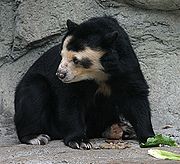
Serranía de los Churumbelos
Encyclopedia

Fundación ProAves
Fundación ProAves is a nonprofit environmental organization in Colombia established in 1998. Its primary aims are to protects birds of conservation concern and their habitats across Colombia.ProAves has over 60 full-time professional staff...
in Conservacion Colombiana in 2007. These studies raised interest in the region and laid the justification for the protection of this spectacular mountain range.
Location
Serranía de los Churumbelos forms the southernmost spur of the Eastern Cordillera of the AndesAndes
The Andes is the world's longest continental mountain range. It is a continual range of highlands along the western coast of South America. This range is about long, about to wide , and of an average height of about .Along its length, the Andes is split into several ranges, which are separated...
, and is situated on the border of 4 distinct biogeographical regions: lowland Amazonia, the Eastern Cordillera, the Central Cordillera and the dryer Magdalena Valley.
Biological Expeditions
The first studies of Serrania de los Churumbelos were carried out by Anglo-Colombian expeditions, "Colombia '98" and "EBA Project", initiatives of Colombian and UK students.The mountain range was found to resemble the Northern Andeean and Amazonia North Ecoregions. Several new plant species were discovered (in Gesneriaceae
Gesneriaceae
Gesneriaceae is a family of flowering plants consisting of ca. 150 genera and ca. 3,200 species in the Old World and New World tropics and subtropics, with a very small number extending to temperate areas. Many species have colorful and showy flowers and are cultivated as ornamental plants.Most...
, Piperaceae
Piperaceae
The Piperaceae, also known as the pepper family, is a large family of flowering plants. The group contains roughly 3,610 currently accepted species in five genera. The vast majority of peppers can be found within the two main genera: Piper and Peperomia .Members of the Piperaceae may be small...
and others). A total of 462 bird
Bird
Birds are feathered, winged, bipedal, endothermic , egg-laying, vertebrate animals. Around 10,000 living species and 188 families makes them the most speciose class of tetrapod vertebrates. They inhabit ecosystems across the globe, from the Arctic to the Antarctic. Extant birds range in size from...
species were recorded in Serranía de los Churumbelos, with 246 species banded
Bird ringing
Bird ringing or bird banding is a technique used in the study of wild birds, by attaching a small, individually numbered, metal or plastic tag to their legs or wings, so that various aspects of the bird's life can be studied by the ability to re-find the same individual later...
. Twelve threatened and near threatened
Near Threatened
Near Threatened is a conservation status assigned to species or lower taxa that may be considered threatened with extinction in the near future, although it does not currently qualify for the threatened status...
bird species were recorded. It is estimated that the probable total bird species inventory exceeds 550 species: an exceptional diversity, making the Serranía a global avian "hotspot" and extremely important for bird diversity.
A total of 46 species of amphibians (30 spp.) and reptiles (16 spp.) were recorded, including four new species for Colombia and several potentially undescribed taxa. Mammals registered include Spectacled Bear
Spectacled Bear
The spectacled bear , also known as the Andean bear and locally as ukuko, jukumari or ucumari, is the last remaining short-faced bear and the closest living relative to the Florida spectacled bear and short-faced bears of the Middle Pleistocene to Late Pleistocene age.The spectacled bear is a...
Tremarctos ornatus and Mountain Tapir
Mountain Tapir
The Mountain Tapir or Woolly Tapir is the smallest of the four species of tapir and is the only one to live outside of tropical rainforests in the wild...
Tapirus pinchaque. 150 Lepidoptera
Lepidoptera
Lepidoptera is a large order of insects that includes moths and butterflies . It is one of the most widespread and widely recognizable insect orders in the world, encompassing moths and the three superfamilies of butterflies, skipper butterflies, and moth-butterflies...
(butterfly) species were recorded.
Environmental issues
The two greatest human pressures infiltrating the Serranía appear to be along the Caquetá River - Miraflor - Piamonte - Puerto Bello road and the PitalitoPitalito
Pitalito is a town and municipality in the Huila Department, Colombia. Its population is 103,850.-External links:*...
- Mocoa
Mocoa
Mocoa is a municipality and capital city of the department of Putumayo in Colombia.The city is located in the northwest of the Putumayo department. The municipality borders the departments of Nariño to the west and Cauca to the north.-External links:...
road. Farming, hunting and cultivation pressures from environmentally poor crops such as coca
Coca
Coca, Erythroxylum coca, is a plant in the family Erythroxylaceae, native to western South America. The plant plays a significant role in many traditional Andean cultures...
and maize are the major threats to conservation
Conservation ethic
Conservation is an ethic of resource use, allocation, and protection. Its primary focus is upon maintaining the health of the natural world: its, fisheries, habitats, and biological diversity. Secondary focus is on materials conservation and energy conservation, which are seen as important to...
in the region.
The steep sided slopes, combined with an extensive altitudinal gradient of Serranía de los Churumbelos have created a number of different ecosystems and micro-habitat zones throughout the area. The myriad of ecosystems and habitats helps explain to some extent the large scale spatial biodiversity of the Serranía. The existence of numerous range extensions in fauna and ecosystems typical of higher altitudes constitutes the Serranía de los Churumbelos as an area of high scientific interest.
A previously unexplored table top massif in the Serranía de los Churumbelos, reminiscent of the Tepuis, was explored in 1998 and named Alto Cagadero (1°14'32.32"N,76°30'28.34"W).

